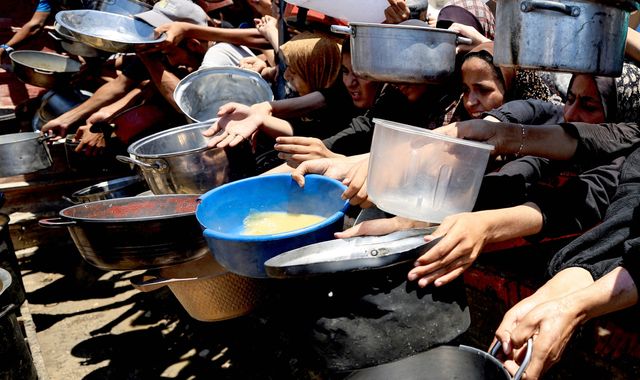It’s hot and dusty and the Israel Defense Forces (IDF) want to make the point that there is aid sitting idle just over the border in Gaza.
This, after the UN described the hunger crisis on top of 21 months of conflict between Israel and Hamas in Gaza as a “horror show”.
The UN says Gaza needs 500 trucks of aid to be distributed a day – and that was before this crisis.
Israel stands accused of presiding over the breakdown of aid in Gaza, but it’s a complex web of accusations.
Israel says there is no famine in Gaza – but aid organisations, including the UN, are aghast, saying even their own staff are struggling to continue working in the face of such a desperate shortage of food.
Israel may be keen to highlight the parked up trucks on the Gazan side – but aid groups say getting the aid to the border is the easy part.
They say distribution is caught up in Israel’s refusal to sufficiently guarantee safe passage to the vehicles, given it controls well over 80% of the land in an active war zone.
Palestinian truck drivers need to be vetted and run the gauntlet of not only the war but also desperate Gazans trying to hijack goods from their lorries.
Israel reminds the world of its accusation that Hamas, which, together with other Islamist groups, is still holding 20 living Israeli hostages, profited from aid going into Gaza until the Gaza Humanitarian Foundation (GHF) took over aid distribution in May.
But the Israeli and American-backed GHF aid sites are mainly in the south of Gaza and Israel is accused of trying to drive people southwards, leaving the north of Gaza pretty much as a place nobody can live.
There are also claims from the Hamas-run Gaza health ministry that around 1,000 people have died at or near GHF sites or trying to get food since the end of May.
Read more:
Surgeon – IDF using Gazans as ‘target practice’
Medics struggle to feed children
Gaza food situation ‘worst its ever been’
The GHF and Israel refute this.
The UN’s aid contribution in Gaza now is a trickle compared to what it was before the GHF took over.
But it is still trying to support people who refuse to leave what’s left of their homes across the sliver of land where more than two million people live, where there is now widespread malnutrition.





























